-
Countries
-
Data and Analysis
-
Special Focus
-
Crisis Responses
Assessment Report
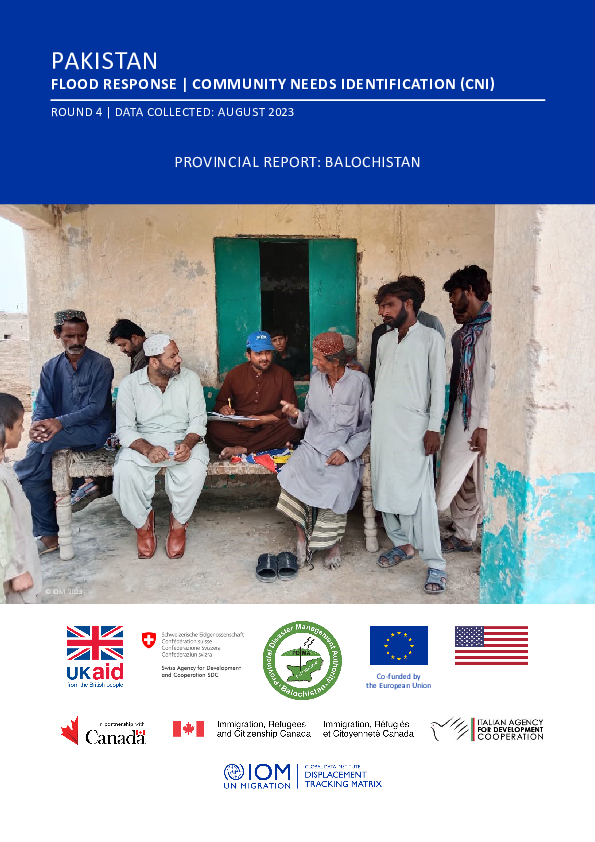
Contact
dtmpakistan@iom.int
Language
English
Location
Pakistan
Period Covered
Aug 01 2023
Aug 31 2023
Activity
- Survey
- Mobility Tracking
- Site Assessment
From June to October 2022, storms and heavy monsoon rains in Pakistan caused widespread flooding and landslides across the country. As of 18 November 2022, according to the National Disaster Management Authority (NDMA), up to 33 million people have been affected by the floods and a total of 90 districts have been labelled by the Government of Pakistan as ‘calamity-hit’.
In August 2023, IOM implemented a fourth round of the CNI to provide partners with timely information on the displacement situation, the multisectoral needs of the affected population as well as the recovery needs at the settlement level.7 For this round, IOM implemented the CNI in nine districts of Balochistan. The CNI was conducted in 3,257 flood-affected settlements or settlements that hosted temporary displaced persons (TDPs) across the nine targeted districts.8

Contact
dtmpakistan@iom.int
Language
English
Location
Pakistan
Period Covered
Aug 01 2023
Aug 31 2023
Activity
- Survey
- Mobility Tracking
- Site Assessment
From June to October 2022, storms and heavy monsoon rains in Pakistan caused widespread flooding and landslides across the country. As of 18 November 2022, according to the National Disaster Management Authority (NDMA), up to 33 million people have been affected by the floods and a total of 90 districts have been labelled by the Government of Pakistan as ‘calamity-hit’.
In August 2023, IOM implemented a fourth round of the CNI to provide partners with timely information on the displacement situation, multisectoral needs of the affected population as well as the recovery needs at the settlement level.6 For this round, IOM implemented the CNI in 10 districts of Khyber Pakhtunkhwa. The CNI was conducted in 3,107 flood-affected settlements or settlements that hosted temporary displaced persons (TDPs) across the 10 targeted districts.7

Contact
DTM DRC, iomdrcdtm@iom.int
Language
English
Location
Democratic Republic of the Congo
Period Covered
Feb 21 2024
Feb 28 2024
Activity
- Mobility Tracking
- Event Tracking
The conflict in the eastern region of the Democratic Republic of Congo (DRC), particularly in the province of North Kivu, has become increasingly complex over the years. Various armed groups, including the M23 group and the Congolese armed forces (FARDC) and their allies, have been involved in the conflict, leading to widespread instability and unprecedented humanitarian crises. The fighting has led to a large-scale displacement and an increasing population in need of humanitarian assistance, access to which remains extremely difficult.
Regional initiatives to improve peace and security in the region have intensified in recent weeks. In addition to the deployment of the Southern African Development Community (SADC) forces last December, initiatives such as the Heads of State summit in Addis Ababa on 17 February 2024 and the Heads of State meeting in Angola on 27 February 2024 took place with the aim of relaunching the peace process, secure a ceasefire between the FARDC and the M23 group and initiate direct dialogue between the Democratic Republic of Congo and Rwanda.
The escalation of tensions in recent weeks has triggered a continued movement of populations from host communities and displaced persons previously living in sites or with host families on the Sake-Bweremana axis towards the province of South Kivu in Kalehe territory, to the direction of Goma and the surrounding areas. However, since the last assessment (23 February), a slight upward trend in returns has been observed after the relative calm period between 21 and 28 February 2024.
Since the beginning of the crisis, IOM, through its Displacement Tracking Matrix (DTM), has continued conducting a series of rapid assessments, including emergency monitoring (EET/ERM), crisis analysis and registration with the aim of responding to immediate information needs in order to understand displacement dynamics.
This report presents the results of assessments carried out in the various displacement and return areas between 21 and 28 February 2024.

Contact
DTM DRC, iomdrcdtm@iom.int
Language
French
Location
Democratic Republic of the Congo
Period Covered
Feb 21 2024
Feb 28 2024
Activity
- Mobility Tracking
- Event Tracking
Le conflit dans la région orientale de la République démocratique du Congo (RDC), en particulier dans le Nord-Kivu, dure depuis des années et a gagné en complexité. Divers groupes armés, dont le groupe M23 et les forces armées congolaises (FARDC) avec leurs alliés, ont été impliqués dans le conflit, entraînant une instabilité généralisée et des crises humanitaires sans précédent. Ces combats génèrent une importante population déplacée et une population encore plus importante ayant besoin d'une aide humanitaire dont l'accès reste extrêmement difficile.
De début février au 28 février, les combats se sont intensifiés autour de Sake, à une vingtaine de kilomètres de Goma, la capitale du Nord-Kivu. L'offensive du groupe M23 du 7 février a exposé les civils aux répercussions de violents combats, caractérisés par des tirs de mortier et d'artillerie à Sake et dans les collines environnantes. Cette situation, en plus des victimes graves, a entraîné un afflux de personnes déplacées vers Goma et les zones environnantes qui ne sont pas encore sous le contrôle du groupe M23, un afflux qui exerce une pression croissante sur les maigres ressources et infrastructures disponibles pour répondre aux besoins des communautés touchées.
L'exacerbation des tensions au cours des dernières semaines a conduit à la poursuite des mouvements de populations des communautés d'accueil et des personnes déplacées précédemment installées dans des sites ou dans des familles d'accueil sur l'axe Sake-Bweremana vers la province du Sud-Kivu dans le territoire de Kalehe, en direction de Goma et de ses environs. Cependant, depuis la dernière analyse de crise du 23 février, une légère tendance à la hausse des retours a été observée après l'accalmie de la période du 21 au 28 février 2024.
Depuis le début de la crise, l'OIM, par le biais de la DTM continue à mener une série d'évaluations rapides, y compris le suivi des urgences (EET/ERM), l'analyse des crises et enregistrement avec priorité de répondre aux besoins immédiats d'information en vue de comprendre la dynamique des déplacements et les besoins. Ce rapport présente les résultats des évaluations menées dans les différentes zones de déplacement et de retour du 21 au 28 février 2024.
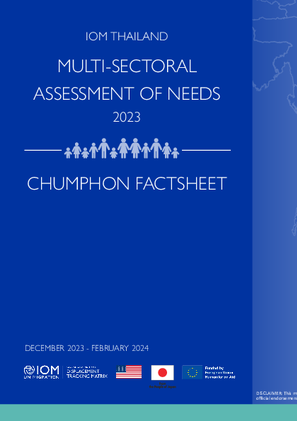
Contact
DTMThailand@iom.int
Language
English
Location
Thailand
Period Covered
Dec 14 2023
Feb 12 2024
Activity
- Survey
- Site Assessment
This factsheet aims to provide a snapshot of multi-sectoral conditions, needs, and challenges among Myanmar migrants in Chumphon province as captured between December 2023 and February 2024 by IOM Thailand’s multi-sectoral assessment of needs. The purpose of this assessment is to provide insights regarding the severity of needs among migrant populations, identify vulnerable population groups and geographic areas with the most acute needs, inform assistance planning and relevant Sustainable Development Goals (SDGs) targets, and provide sectoral and inter-sectoral baselines for future assessments.
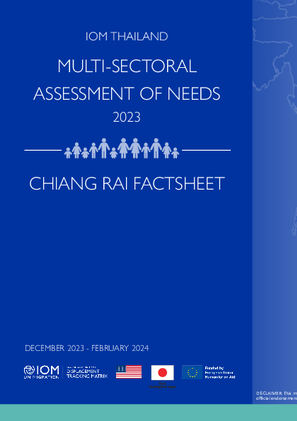
Contact
DTMThailand@iom.int
Language
English
Location
Thailand
Period Covered
Dec 20 2023
Feb 05 2024
Activity
- Survey
- Site Assessment
This factsheet aims to provide a snapshot of multi-sectoral conditions, needs, and challenges among Myanmar migrants in Chiang Rai province as captured between December 2023 and February 2024 by IOM Thailand’s multi-sectoral assessment of needs. The purpose of this assessment is to provide insights regarding the severity of needs among migrant populations, identify vulnerable population groups and geographic areas with the most acute needs, inform assistance planning and relevant Sustainable Development Goals (SDGs) targets, and provide sectoral and inter-sectoral baselines for future assessments.
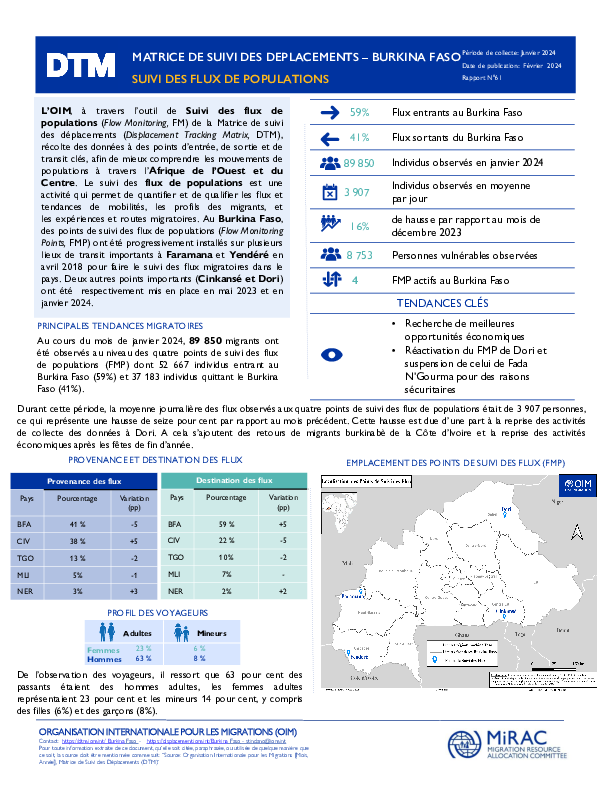
Contact
DTM Burkina Faso, BFInformationUnit@iom.int
Language
French
Location
Burkina Faso
Period Covered
Jan 01 2024
Jan 31 2024
Activity
- Flow Monitoring
L’OIM, à travers l’outil de Suivi des flux de populations (Flow Monitoring, FM) de la Matrice de suivi des déplacements (Displacement Tracking Matrix, DTM), récolte des données à des points d’entrée, de sortie et de transit clés, afin de mieux comprendre les mouvements de populations à travers l’Afrique de l’Ouest et du Centre. Le suivi des flux de populations est une activité qui permet de quantifier et de qualifier les flux et tendances de mobilités, les profils des migrants, et les expériences et routes migratoires. Au Burkina Faso, des points de suivi des flux de populations (Flow Monitoring Points, FMP) ont été progressivement installés sur plusieurs lieux de transit importants à Faramana et Yendéré en avril 2018 pour faire le suivi des flux migratoires dans le pays. Deux autres points importants (Cinkansé et Dori) ont été respectivement mis en place en mai 2023 et en janvier 2024.
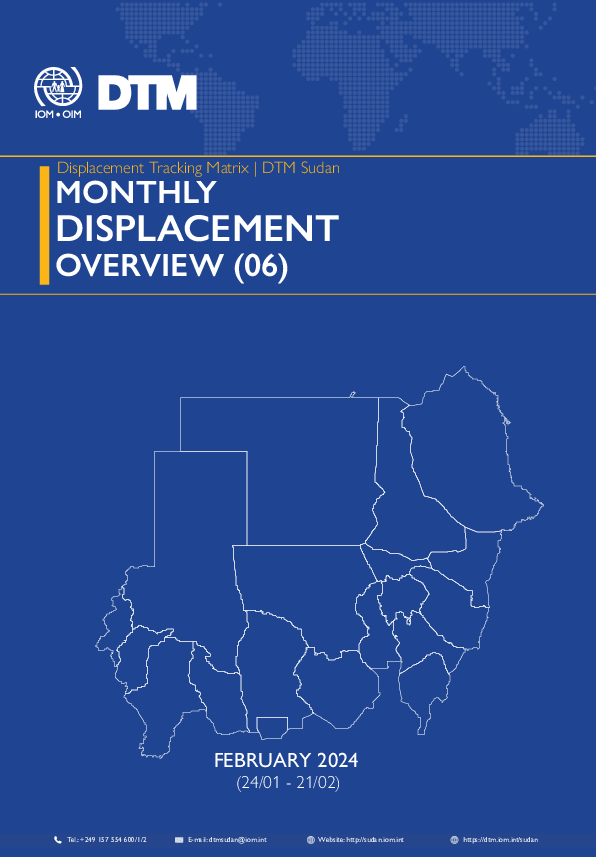
Contact
DTM Sudan, DTMSudan@iom.int
Language
English
Location
Sudan
Period Covered
Jan 24 2024
Feb 21 2024
Activity
- Mobility Tracking
- Baseline Assessment
Overview
IOM DTM Sudan presents its sixth Monthly Displacement Overview. This publication provides an account of Sudan’s displacement context since 15 April 2023 – outlining population mobility and displacement, as well the present and evolving needs of IDPs across Sudan.
Rationale
Recognizing the need for more detailed insights into the IDP situation, including the priority needs, access to services, movement intentions, and demographic breakdowns of the affected population, DTM Sudan has undertaken a comprehensive review of our data collection tool. In collaboration with a wide range of internal and external stakeholders, we have developed a new tool to better inform humanitarian response operations, aligning with the DTM global methodology. Leveraging our extensive network of approximately 367 field-based enumerators and a robust system of over 3,266 key informants across the country, DTM gathered data on IDPs across 6,845 locations, in 179 of Sudan’s 189 localities, across all of Sudan’s 18 states, during February 2024.
Key Findings
- DTM Sudan estimates that 6,326,416 individuals (1,261,060) households) have been recently internally displaced.
- IOM DTM also reports that an estimated 1,884,909 mixed cross-border movements have been made into neighbouring countries.
- Since 15 April 2023, 46 per cent of the IDP caseload sought refuge in the Darfur and Kordofan regions, whereas 53 per cent were observed across the Northern, Eastern, and Central states.
- The majority of the IDP caseload (66%) were seeking shelter with the host community.
- While food remains the highest priority need, health and non-food items are also growing concerns.

Contact
dtmlebanon@iom.int
Language
English
Location
Lebanon
Period Covered
Oct 10 2023
Feb 27 2024
Activity
- Mobility Tracking
- Baseline Assessment
Since October 8 there has been an increase in cross-border incidents between Israel and Lebanon, resulting in the displacement of people both within the South and elsewhere within the country. Since October 10, the Displacement Tracking Matrix (DTM) has been conducting the daily monitoring of population movements. The objective of the exercise is to inform preparedness and response planning.
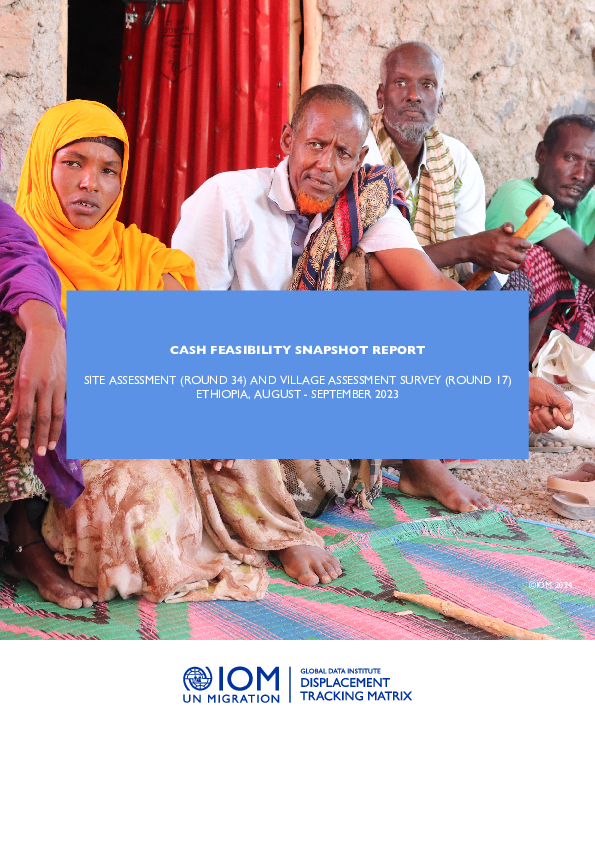
Contact
DTM Ethiopia, DTMEthiopia@iom.int
Language
English
Location
Ethiopia
Period Covered
Aug 01 2023
Sep 02 2023
Activity
- Mobility Tracking
- Site Assessment
- Village Assessment
Between August and September 2023, the International Organization for Migration (IOM) Data and Research Unit (DRU), through its Displacement Tracking Matrix (DTM) methodology, deployed the Site Assessment (SA) and Village Assessment Survey (VAS) tools to assess the mobility, needs and vulnerabilities of Internally Displaced Persons (IDPs) and returning IDPs across Ethiopia. This snapshot report will present key findings on needs and vulnerabilities, in particular those related to Cash and Voucher (CVA) assistance.
It is recommended to utilize cash and mixed modality (cash + in-kind) responses for these population groups if feasible. The finding that 80.5% of sites and 75.7% of villages mentioned a preference towards cash, whether by itself or mixed with in-kind/baskets, aligns with Ethiopia Cash Working Group (CWG) recommendations based on joint CVA feasibility assessments.
Pagination
- Previous page
- Page 47
- Next page
